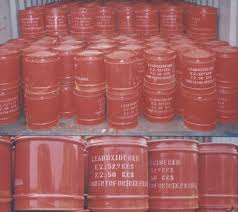Red Lead
| Infobox on Red Lead | |
|---|---|
| Example of Red Lead |  |
| Facts | |
| Origin | - |
| Stowage factor (in m3/t) | 1,4 m3/t (drums) |
| Humidity / moisture | - |
| Ventilation | - |
| Risk factors | See text |
Red Lead
Description
Lead oxide, also called minium, red lead or triplumbic tetroxide, is a bright red or orange crystalline or amorphous pigment. The product is partly soluble in acids, insoluble in water. Decomposes between 500ºC and 530ºC.
Lead oxide is prepared by calcination of lead oxide (also called litharge) in air at about 450°C to 480°C.
Application
Lead tetraoxide is most often used as a pigment for primer paints for iron objects. Due to its toxicity, its use is being limited. In the past, it was used in combination with linseed oil as a thick, long-lasting anti-corrosive paint. The combination of minium and linen fibres was also used for plumbing, now replaced with PTFE tape. Currently it is mostly used for the manufacture of glass, especially lead glass. It finds limited use in some amateur pyrotechnics as a relatively potent oxidizer.
Red lead is used as a curing agent in some polychloroprene rubber compounds. It is used instead of magnesium oxide to provide better water resistance properties.
Shipment / Storage / Risk factors
A bright red powder, usually shipped in drums. Is toxic as a dust and precautions should be taken against contamination of other goods, particularly foodstuffs, food containers and packaging materials.
Special precautions should be taken in handling this product. Would require reprocessing if wetted.
Toxic as dust, TLV (as Pb): 0,15 mg/m3 of air. Consult the applicable MSDS sheet.











